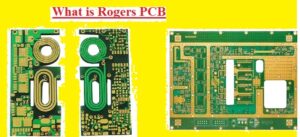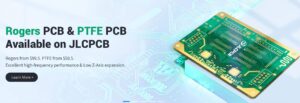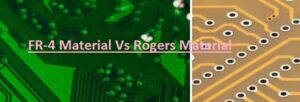 Rogers PCB board is a high-performance PCB board substrate material made by laminating the different layers with use of certain materials. Its name is Roger due to Rogers Corporation, which is a famous manufacturer of high-performance engineered materials.
Rogers PCB board is a high-performance PCB board substrate material made by laminating the different layers with use of certain materials. Its name is Roger due to Rogers Corporation, which is a famous manufacturer of high-performance engineered materials.
What is Rogers PCB?
- Roger is a manufacturer that makes laminate materials used for making PCB boards. Most circuit boards are created using FR4, a glass fiber composite with copper foil laminated on board sides. Rogers provides teh FR4 laminates and is best for cores with high-frequency features, like PTFE.
- it is more cost than fiberglass and less lossy for high temperatures. So they are best for RF circuit boards.

Properties of Rogers PCB
Materials
Roger material features come with certain advantages that help PCB manufacturers solve the limitations and push limits for electrical performance and reliability.
High-Frequency Performance
The main features of these materials are high-frequency performance, stability, and less loss operation for mmWave frequencies. it causes
- Deficient dissipation factor
- dielectric constant consistency for frequency
- The low value of the coefficient of thermal expansion
Reliability and Consistency
- Consistency and stability are the main features to offer a reliable working life and working for different temperature conditions.
- It has a good z-axis coefficient of thermal expansion according to copper.
- It has a high glass transition temperature.
- It offers low moisture absorption, the best adhesion, and Low outgassing
Thermal Management Capability
Best heat dissipation is required for good working and avoiding hot spots in high-power devices.
The main thermal features of Rogers’ materials are:
It offers high thermal conductivity and low thermal coefficient of dielectric constant and less thermal expansion
It has high glass transition temperatures
Broad Design Flexibility
Rogers also offers different dielectric constant values, loss tangents, thickness, reinforcement materials, copper categories, and other features. This material features offers design flexibility for providing optimal electrical, thermal, and mechanical characteristics.
Low dielectric constant (Dk):
- Rogers PCB materials come with low dielectric constants that is about 2.2 and 3.5 which means can maintain signal quality and reduce signal losses for high frequency and longer distances
Low loss tangent (Df):
- Rogers board materials come with low tangents about 0.001 and 0.002, that menas can reduce signal attenuation and distortion.
High thermal conductivity:
- Roger PCB materials come with high thermal conductivity, about 0.5 and 2 W/mK, so they can effectively dissipate heat and maintain stable operations for different temperatures.
Dimensional stability:
- This material comes with less thermal expansion (CTE), 10 and 17 ppm/°C, so is less to warp or deform under temperature changes.
Uniform material structure:
- These materials come with a uniform material structure menas offers consistent performance across the board.
Cost
- Due to the high cost of the Rogers material and the manufacturing process, these boards more expensive than conventional FR-4 PCB. Specialized tools and procedures with experts like JLCPCB are needed for Rogers PCB manufacturing, which raises the price.
Rogers PCB materials Formulations
Rogers RO4000 series:
- it is a high-frequency laminate with low dielectric loss and low moisture absorption.
Rogers RO3000 series:
- It is high frequency laminate having low tangents and good dimensional stability.
Rogers RT/duroid series:
- The high-frequency materials come with high thermal conductivity and low-loss tangents.
Rogers TMM series:
- It is a high thermal conductivity material having less dielectric loss and high thermal stability.
Roger pcb by JLCPCB
A well-known producer of printed circuit boards, including Rogers PCB, is JLCPCB. In this review, we’ll examine the Rogers PCB from JLCPCB in more detail.JLCPCB has been working nonstop to save expenses and increase efficiency since 2006. They pledge to always provide clients with the most affordable PCBs. JLCPCB produces PCBs at a low cost yet of the highest quality, presumably as a result of economies of scale, exceptionally high manufacturing efficiency, and low labor costs.
JLCPCB is a Chinese-based PCB manufacturer that offers a wide range of PCB services, including Rogers PCB. JLCPCB’s Rogers PCB is designed for high-frequency and high-speed applications, making it suitable for industries such as telecommunications, aerospace and defense, medical devices, automotive, and consumer electronics.
Just by selecting the appropriate base material on the JLCPCB site, you can quickly obtain high-quality high-frequency PCBs. They can provide a discount pricing for both HF base materials within 10cm*10cm 5pcs because of their large-scale production capability; Rogers PCBs start at $99.5, and save you more than $100 compared to other HF PCBs on the market. Specifications for Rogers PCB on JLCPCB
- PCB Thickness:0.51/0.76/1.52
- PCB Laminates: RO4350B (Dk=3.48, Df=0.0037)

Features of JLCPCB Rogers Boards
- Glass-reinforced Hydrocarbon and ceramic dielectric
- Volume manufacturing process
- Excellent high-frequency performance
- Low Z-Axis expansion, excellent dimensional stability
- Integrated thin film resistor benefit
- CAF resistant
- Easy to afford
How to order Rogers PCB on JLCPCB
- First of all visit the JLCPCB site: https://jlcpcb.com/ILV
- You can see the below figure add the Gerber file option to upload your Gerber file here
- Then choose the Roger option according to your project requirements
- Now choose PCB thickness and PCB Laminates
- After that choose other specifications according to need and finally save to the cart and checkout
Advantages of Rogers PCB
Rogers-RO4350B:
This material is high-strength glass hydrocarbon/ceramic material and comes with a dielectric constant of 3.48 at 10GHz, which makes it used for high-frequency power amplifier designs.
The RO4350B laminate comes with a low Z-axis coefficient of thermal expansion (CTE), that offers high stability of multilayer circuits interconnected with plated through holes (PTH).
What is FR-4 material?
FR4 is the grade of materials than material, that is composite materials for glass reinforced expo laminate materials.
FR4 is made with the use of woven fiberglass cloth with epoxy resin joins that is flame-resistant.
FR is flame retardant and denoted that materials come with standard UL94V-0.
Difference Between FR-4 Material And Rogers Material

- FR4 is lower cost than Rogers material.
- As compared to FR4 Roger is best with high frequencies.
- FR4 is a high Df or dissipation factor thatn roger material, causes more signal loss.
- For impedance stability, Roger material comes with a larger range of Dk value than FR-4 material.
- For dielectric constant, FR4 comes with a Dk of about 4.5 which is less than Rogers material with 6.15 to 11.
- For temperature handling, ROgers come with less change than FR-4 material.
Why Rogers PCB material?
FR4 materials come with the basic standards for PCB substrate, providing the best balance for cost, durability, operation, manufacturing process also electrical features. But operation and electrical features are important for designs, Rogers materials come with some benefits.
- Less electrical signal loss
- Low-cost PCB fabrication
- Less dielectric loss
- Good thermal management
- Different range of Dk (dielectric constant) values (2.55-10.2)
- Low outgassing for space uses
- Good impedance control
Difference between Rogers, Teflon & High-Frequency PCBs
| Property | Rogers PCB | Teflon PCB | High-Frequency PCB |
|---|---|---|---|
| Dielectric Constant | 3.5 | 2.1 – 2.3 | 3 – 3.7 |
| Dielectric Loss | Low | Low | Low |
| Signal Loss | Low | Low | Low |
| Moisture Absorption | Low | Very Low | Low |
| Thermal Conductivity | High | Low | High |
| Cost | High | High | High |
| Applications | Aerospace | Microwave Communications, | High-Frequency Applications, |
Comparison
FR4
- The dielectric constant is around 4.4
- Not suitable for high-speed applications
- affordable
- Used for consumer electronics, automotive, and industrial equipment
- The dissipation factor is a Higher
- Low thermal conductivity
- Dimensional stability is Lower
Rogers Material
- The dielectric constant is about 3.5
- High speed and high frequency uses
- High cost
- best for telecom and aviation industry
- Dissipation factor is low
- Thermal conductivity is high




